I Cant Seem to Download Macos Sierra Again
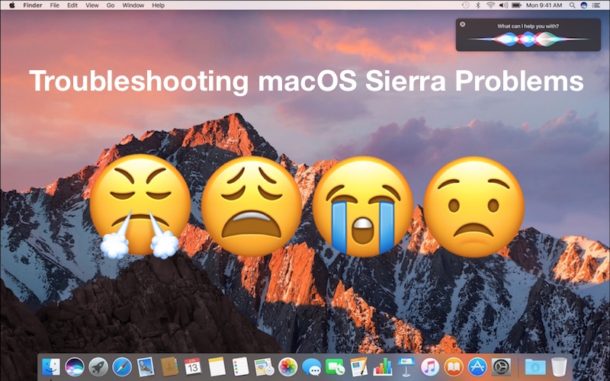
For about users, installing macOS Sierra has gone without a hitch and they're left with a trouble-free Mac that works keen with the latest macOS system software release. But, non everything goes smoothly for anybody, and sometimes updating to macOS Sierra can atomic number 82 to a multifariousness of bug.
We're compiling a list of common problems in this troubleshooting guide to remedy issues with the macOS Sierra download, installation, update, and mail-install process. Unfortunately for me (but fortunately for you readers), I personally have had the joy of encountering many of these issues during and after updating one particular MacBook Pro to Mac OS Sierra 10.12, so I have very recent extensive firsthand experience with troubleshooting much of what is covered here.
To be perfectly clear this is meant to exist a compilation for potential issues experienced with the macOS Sierra update process. Near of this will not be encountered by the average user, and is in no way suggestive of what to await during the Sierra update or installation process. The vast bulk of Macs update to macOS Sierra without any adverse incident.
macOS Sierra Download Stops with "An error has occurred" or "failed to download"
Sometimes when users attempt to download macOS Sierra from the Mac App Store they will face up a "An error has occurred" scarlet bulletin and the download stops.
The solution to this is fairly straight forward: Delete any existing Sierra installers, whether they are half-downloaded or non, reboot the Mac, and try again.
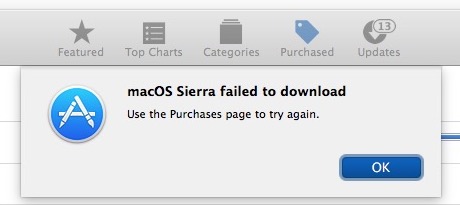
I ran into variants of the download problem several times. What finally resolved information technology was to delete the half-cooked "Install macOS Sierra" file from Launchpad (which had a big question mark on it), then rebooting.
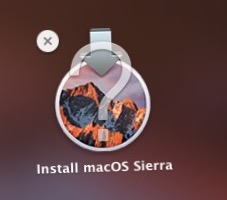
Unable to Download macOS Sierra, shows as "Downloaded"
If the Mac App Stores shows that "macOS Sierra" has "Downloaded" and the push is not possible to click again, you likely had i of the beta or GM builds and you volition demand to remove any existing "Install macOS Sierra" awarding installers from the Mac, or whatever continued drives. That last function is disquisitional, because it appears the Mac App Store has no trouble locating a named "Install macOS Sierra.app" located on an external volume. Yes this includes even the GM builds which share the same proper name every bit the installer app, and prevents the installer from downloading again.
Of course the other reason macOS Sierra will show as "Downloaded" under the Mac App Shop Purchases tab is if you are actively running macOS Sierra, in which example you will not be able to re-download the installer easily.
Error "This re-create of the Install macOS Sierra.app application is damaged, and can't be used to install macOS."
Something happened during the installer download where it was either interrupted or became corrupted. Typically this means the internet connection was disrupted, or the file itself somehow was interfered with during the transfer.
Yous will need to delete the "Install macOS Sierra.app" and download it again from the Mac App Shop.
MacOS Sierra Wi-Fi is Dropping or Unusually Slow
Some Sierra users have found wi-fi drops or is abnormally tiresome. If this applies to you, yous will likely need to trash the wi-fi prefs and then create a new network location to resolve wireless networking bug like this. We have a detailed guide to prepare wi-fi issues with macOS Sierra here.
- Read how to fix wi-fi problems in macOS Sierra
The good news is that wi-fi trouble is commonly really easy to prepare and the above commodity details specific steps to take which remedy the vast majority of wireless networking difficulties.
macOS Sierra Boots to Black Screen, Stuck on Blackness Screen
Some users have discovered that macOS Sierra will boot to a blackness screen and get stuck, unable to go further. This gives the appearance that the Mac is off, merely it's actually on and the screen is only stuck night, with the Mac doing who knows what. This tin happen right later the initial installation, but as well during a standard Mac system restart afterward having updated to Sierra. I personally experienced this in the latter scenario during a regular reboot, and as you tin can imagine information technology'southward fairly annoying to discover the Mac won't kicking up normally. Fortunately with prior experience handling a similar effect, I was able to resolve it with the following steps in this club:
- Disconnect all USB cables and USB devices from the Mac, aside from a mouse or keyboard if applicative
- Shutdown the Mac
- Reset SMC
- Reset NVRAM/PRAM
- Boot as usual
It may non be necessary to reset both PRAM/NVRAM and SMC, but since you're already doing ane yous might as well do the other. You'll lose a few basic power settings by doing then, only it'southward not a big bargain, and it resolved the stuck on black screen issue for me.
Some MacOS Sierra users take reported similar issues with their Mac getting stuck on a blackness screen when waking from sleep. Often the same SMC and NVRAM reset process remedies those difficulties.
Unable to Close Down macOS Sierra, Unable to Reboot macOS Sierra
At that place appears to be a bug for some users that prevents the Mac from using the Apple tree bill of fare Shut Downwards and Restart services. Selecting the menu items results in no activity and no action, the Mac does not reboot and it does non close downward.
Sometimes a third political party app can be belongings upward the shut down and restart service, notwithstanding. If you suspect this is the case, quit out of all open apps earlier attempting to shut downwardly or restart the Mac. You can likewise try disconnecting all external devices, which has been reported to help some users shut down MacOS Sierra.
The other choice is to forcibly shut down and reboot the Mac past property downwards the Ability key. The forced shut down and forced reboot procedure is a measure out of last resort and should non exist used as a means of initiating any normal restart or close down process.
Some users have resolved the hanging on shutdown issue by rebooting into Safe Mode. Booting a Mac into safe mode is easy, just hold downwardly the SHIFT cardinal on system kick until you see the bootup progress bar, then let go. Rubber Mode will clear out some caches and disable some functionality, but it can often be a helpful troubleshooting mensurate.
Constant iCloud Error and iCloud Authentication Pop-Upwardly Letters
Many components of macOS Sierra are dependent on iCloud, and during the initial setup process yous'll be asked to enable various iCloud features including Storage Optimization and iCloud Documents and Desktop. Whether you want to use all of those features or not is up to you, but an odd side result encountered past some is constant iCloud fault messages and popular-ups to authenticate.
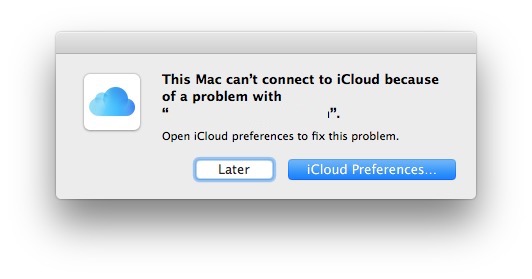
Two persistent popups that I was running into were "This Mac tin can't connect to iCloud because of a problem with (e-mail address)" and "Mistake connecting to iCloud".
I was able to fix the iCloud errors and make them go away by doing the following:
- Go tot he Apple bill of fare and cull System Preferences
- Go to "iCloud" and click on "Sign Out"
- Reboot the Mac
- Render to the iCloud preference console ( Apple carte > Organisation Preferences) and log back into iCloud
Subsequently logging out and back into iCloud, the iCloud error pop-ups went away.
Safari Can't Find Server, Unable to Load Webpages, Links Don't Work, Can't Return CSS
Some users are reporting that Safari is problematic later updating to macOS Sierra, where links don't piece of work at all, or you type a URL into the address bar and hitting return and nothing happens.
If y'all experience the unresponsive URL result upshot, you tin empty caches in Safari for Mac, then quit and relaunch the app and it should work fine again.
Another separate problem with Safari in macOS Sierra seems to be sporadic difficulties loading webpages and contacting servers, leading to an inability to load whatsoever webpage at all.
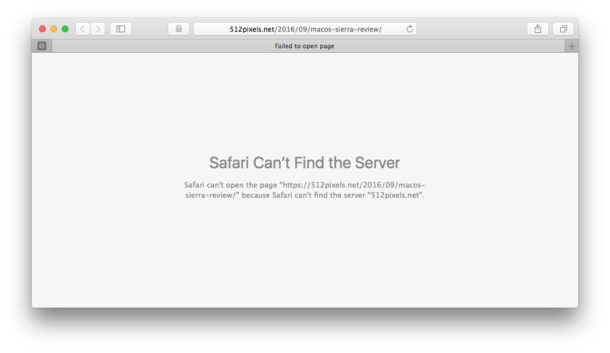
A quick side note: the "tin can't find server" bulletin tin be due to wi-fi dropping, so if the connection difficulties are not express to Safari you may want to use the wi-fi prepare mentioned above.
Another odd variation of this is Safari failing to load webpages repeatedly, but after persistent refreshing, Safari may be able to successfully load a webpage but minus CSS (CSS beingness what styles the majority of webpages).
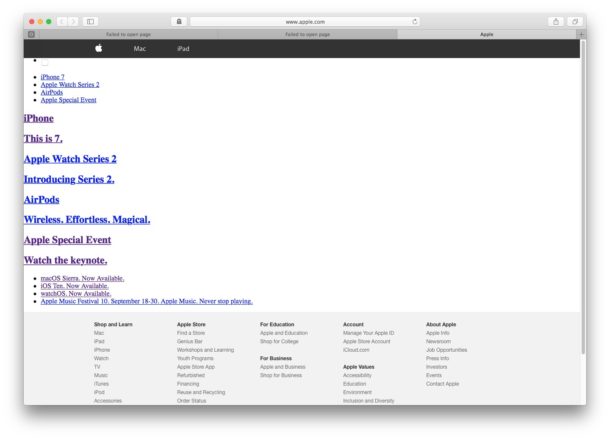
Additionally, another oddball Safari problem is when the browser URL bar and buttons vanishes entirely and no webpage loads at all.
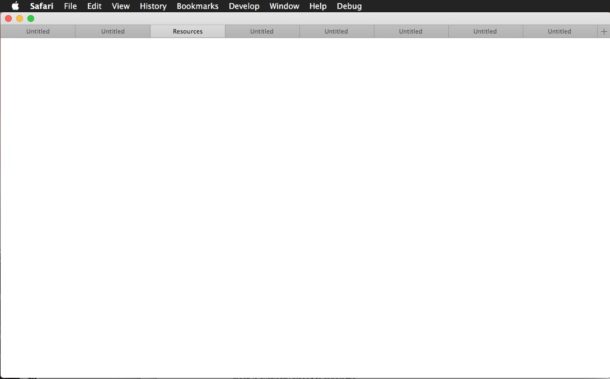
Sometimes quitting and relaunching Safari volition remedy these issues, but ordinarily you will need to reboot the Mac to get Safari working once again for a while.
Some other unusual error message y'all may meet with Safari problems in macOS Sierra is an disability to load a webpage, where the tab or window renames itself to "Resources" and you lot become a blank page loading stating: "Your copy of Safari is missing important software resource. Please reinstall Safari."

Since you lot can't really "reinstall Safari" in macOS Sierra, the error recommendation is not especially helpful, and instead y'all'll probable desire to reinstall all of macOS Sierra or revert to the prior Mac Os version from a fill-in.
Spotlight Doesn't Piece of work with macOS Sierra
Some users, myself included, have noticed that Spotlight only stops working entirely at random in macOS Sierra 10.12. Sometimes Spotlight will sort of half-work, but the results returned are completely inaccurate and don't lucifer the search term. This is not because of indexing, mdworker, or mds, even so. You tin impale the Spotlight process, it will spin support, just the Spotlight search ability does not regain functionality.

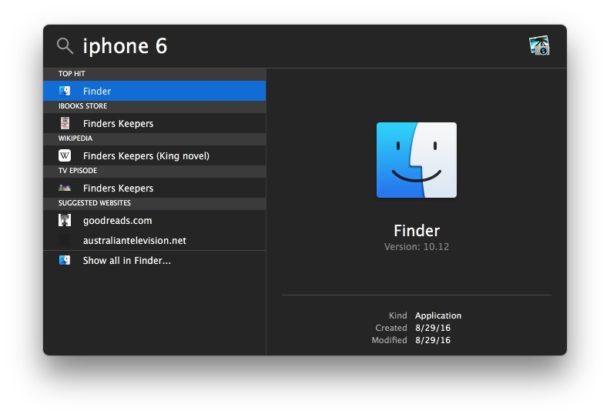
The only style to render Spotlight functionality in this situation is to reboot the Mac. Inconvenient, a bit Windows-esque, but it works.
Yous tin also try to rebuild the Spotlight alphabetize directly, merely yous'll still probable need to reboot the Mac to take Spotlight outset working again equally expected.
Mouse Not Working, Mouse Functionality is Erratic with macOS Sierra
Some users have discovered their mouse is non working at all, or the mouse may be working erratically after updating to macOS Sierra. For instance, the scroll wheel functionality may become unresponsive or not work equally intended. Some of these mouse issues accept been narrowed down to Logitech and Razor brands, perhaps pertaining to drivers or software, but some of the erratic mouse behavior can occur with generic USB mice equally well.
1 possible fix for these issues is to connect the USB mouse direct into the Mac, rather than going through a USB hub.
Mac is Hot, Mac Fans Running at Full Speed Later macOS Sierra Installation
If the computers fans are running later on updating to MacOS Sierra and the Mac feels hot to the touch, it'due south very likely to because the Mac is indexing. This is not indicative of a trouble in and of itself, and it's perfectly normal for the Mac to require reindexing the entire hard bulldoze for features like Spotlight and Siri to work. Additionally, the new Photos app for Mac index the Photo library to identify places, features, faces and people, and other landmarks, which can also take a while. Information technology'southward too likely that Fourth dimension Machine will be running to backup the Mac again later updating the system software. Only let all of these processes complete, exercise not intervene.
Thus, if the Mac is running warm or the fans are blazing away after updating to macOS Sierra, the all-time thing yous tin do is only await. The vast majority of the time the indexing process just needs to run and complete, and the Mac will become usable with low fan usage and a cool temperature once more.
For about users this procedure tin can take an hour or so, but with many documents or Photos, information technology tin can take quite a bit longer. If the Mac is nevertheless misbehaving later leaving it to index overnight, open the "Activeness Monitor" application (plant in /Applications/Utilities/) and sort by CPU, so that loftier CPU usage is at the top. This volition tell you what (if any) applications or processes are consuming the processor and could give you an thought of where to await to troubleshoot further, which is typically an errant task or process.
macOS Sierra Video Problems, Hypercolor Rainbow Display Craziness
This is a weird i that I experienced on a Retina MacBook Pro: the congenital-in display suddenly encountered severe video brandish problems, ranging from improperly rendered driblet-shadows to – and hither's where information technology gets really out in that location – psychedelic hypercolor rainbow display oddness, permeating throughout diverse onscreen elements.
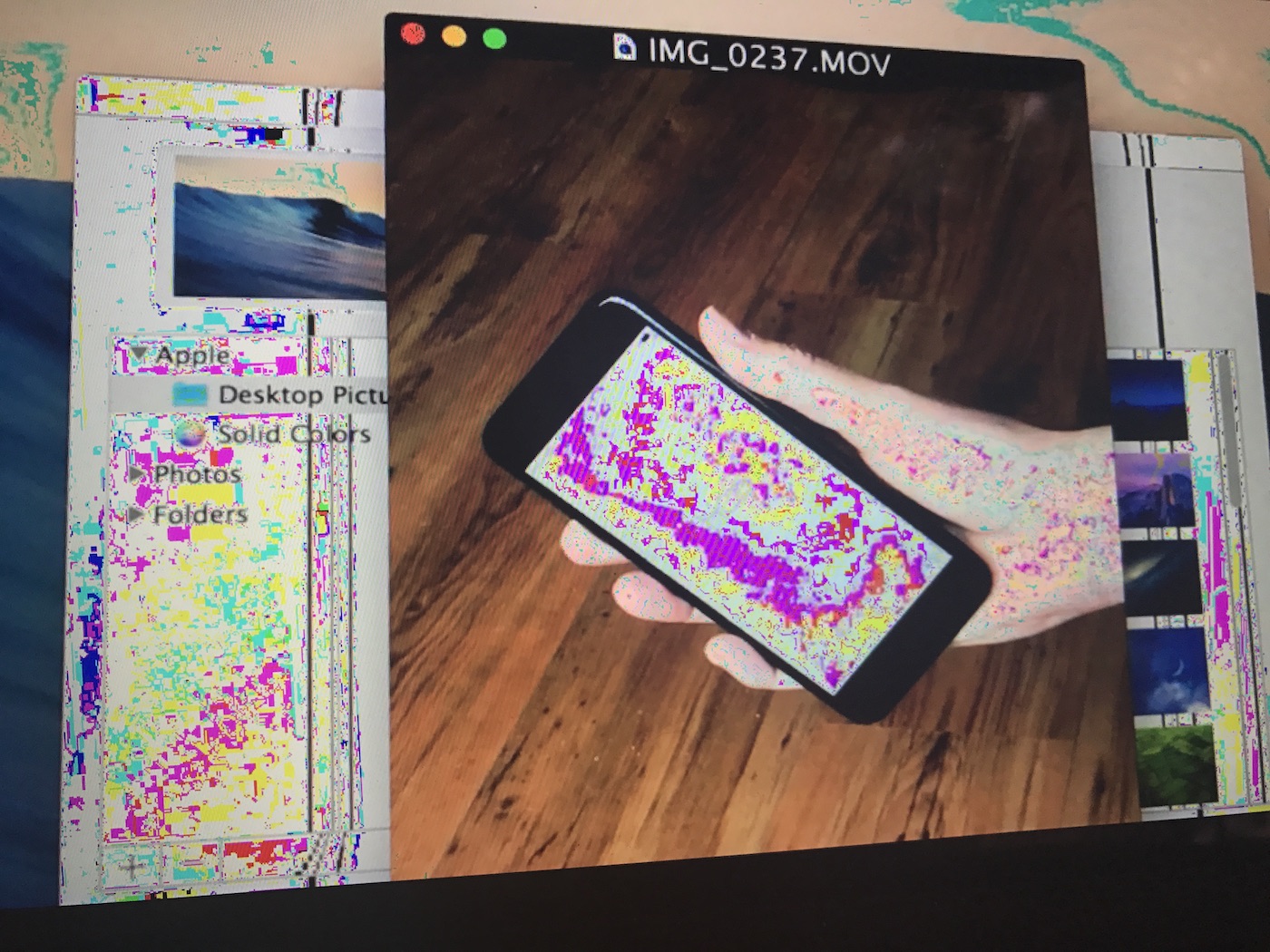
In addition to the psychedelic colour experience, dropshadows and other UI elements would appear evidently broken and display errantly:
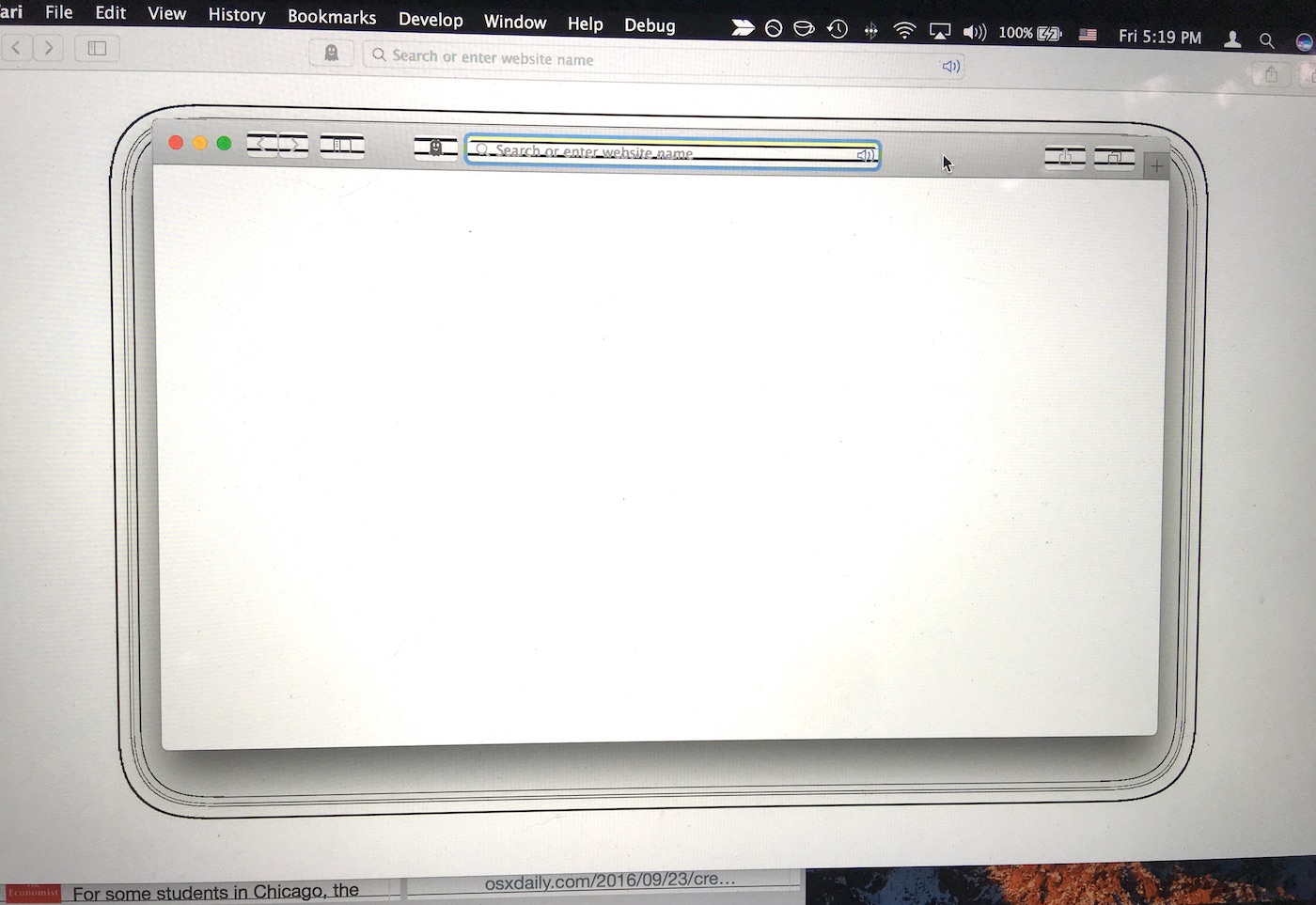
Here'southward a cursory video demonstrating what the crazy video situation looks similar on a Retina MacBook Pro display when information technology'due south irresolute wallpapers:
The solution? Another SMC reset.
And yes, if you're post-obit along, that's 2 different occasions where trouble after updating to macOS Sierra was resolved with an SMC reset…. hmm.
Finder Non Responding, Apps Crashing Constantly, Apps Won't Open up, Constant Beachballs
Finder not responding? Apps not responding? Apps won't open up? Apps say they are damaged? Constant inappropriate beachballs for no apparent reason? Well, you can temporarily remedy these problems past rebooting the Mac. Then rebooting the Mac again. And over again.

But here's the bad news; if y'all are experiencing those type of issues consistently and accept to reboot once or twice a day as a temporary workaround, yous should give in and reinstall macOS Sierra.
![]()
Speaking from direct feel, I battled and troubleshooted for several days the unresponsive apps, apps unable to open, inappropriate beachballing, merely no matter what I did, no matter how many caches and app data was trashed, whatsoever troubleshooting hoops I jumped through, the problems returned in a matter of time after the next reboot.
The simply way to finally remedy these issues was to completely reinstall macOS Sierra via Recovery Mode. It takes a little while, but it seemed to have fixed the problem (for at present anyway, knock on wood). Update: reinstalling macOS did not ready this problem on my specific MacBook Pro, your results may vary.
"The application 'name' tin can't be opened" or Fault -41
A variant of an same error message where apps don't open is when the awarding reports a direct error bulletin when trying to open, often in the form of an onslaught of fault pop-ups stating "The application (proper name) tin't exist opened" and sometimes accompanied past an "Error -41" message popular-up message. This seems to occur afterward macOS has
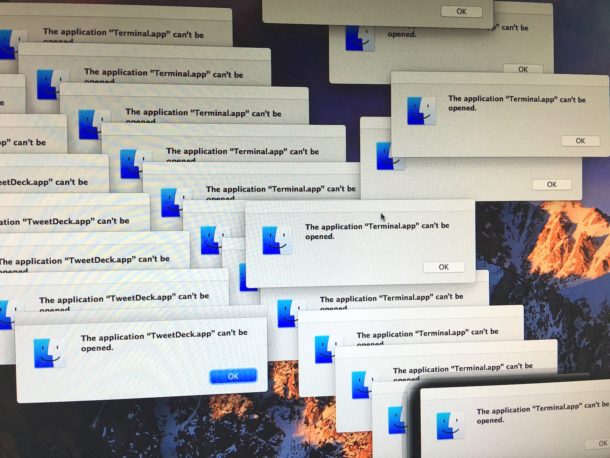
The only solution to this particular meltdown of macOS Sierra is to reboot the Mac. If y'all continuously experience this error or variations thereof information technology is probable a good idea to wipe the drive and clean install macOS Sierra.
Kernel "File: table is full" Errors Filling Console Log
On some user configurations, there appears to be a problem with Mac Bone not properly closing files, though it is unclear what the cause or solution is. Eventually this can lead to "kernel file: table is full" errors flooding the Console log, requiring a manual forced reboot.
Time Machine Stuck "Preparing for Backup" in macOS Sierra
A fair corporeality of macOS Sierra users who rely on Time Machine for backups take discovered the Time Car backup is perpetually stuck on "Preparing backup". There are several possible reasons for Sierra and Time Machine to non work well together. One of the about common causes is a third party app, typically anti-virus software from Sophos or elsewhere, which seems to interfere with Sierra and Time Automobile backups.
If you have Sophos Antivirus or whatever other Mac antivirus or similar scanning or "cleaner" software installed, disable it. Time Machine should resume backups in one case the software is disabled.
If you accept disabled all antivirus software on the Mac and Time Auto is yet not working in Sierra, try this fix for when Fourth dimension Automobile is stuck on preparing backup which involves disabling Time Machine and trashing a temporary file.
Sierra Bricked Mac Completely
A bricked Mac means it won't boot up at all. This is very rare, but at that place are varying reports online of Sierra just outright bricking a Mac after a failed install.
If this happens, you'll well-nigh certainly need to initiate a reinstall process of macOS or Mac OS X, though some users have had to go so far every bit to accept their reckoner to an Apple Store for easily-on support.
Troubleshooting Difficult macOS Sierra Issues
I of the best means to troubleshoot some of the same unusual or more difficult Sierra problems is to create a split up Ambassador user business relationship on the Mac, and utilise that new split up account exclusively for a few days while performing regular computing activities. The reason for this is quite simple; if the trouble does not occur on a separate user business relationship, it suggests the underlying crusade is related to the other user account, perhaps in the course of a corrupt preference file or a process that is unique to that user account.
The fundamental is to create a brand new user account, and so log out of any other user accounts on the Mac. Only use the newly created user account as y'all attempt to reproduce the problem.
- Open System Preferences from Apple menu and go to "Users & Groups"
- Add together a new user, named something obvious like "Troubleshooting" and set it as Administrator
- Log out of the existing user account (and log out of any other user accounts as well)
- Log into the newly created Administrator exam business relationship and try to reproduce the difficulty here
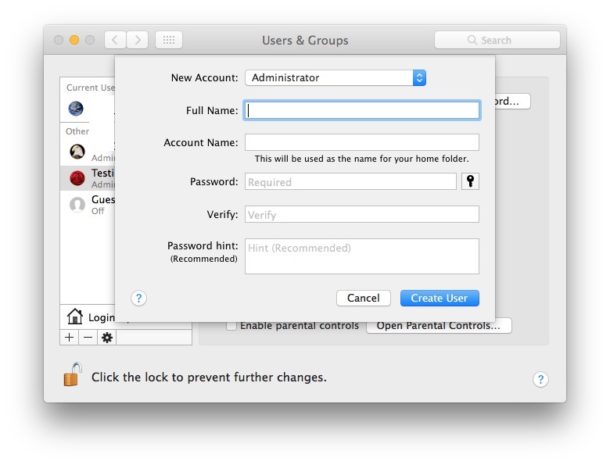
If the problem even so occurs in the new user business relationship, it suggests a deeper upshot with the Mac OS systems software, an underlying system-wide process, or even the specific installation of MacOS.
Backing up thoroughly and so performing a clean install of macOS Sierra may offer a resolution or improvement to an upshot that is reproducible from a new fresh user account.
If the problem returns after a clean install, in that location may exist an outright bug with macOS, or there may be a problem with the Mac itself. If possible, contact the official Apple Support channels for farther help. Downgrading macOS Sierra to El Capitan or Mavericks may offer a solution likewise.
Disconnect Peripherals, Quit Apps, Endeavour Again. Does the Trouble Still Occur?
Another common troubleshooting technique for diverse problems is a process of elimination.
Try disconnecting all peripherals (except a mouse and keyboard if applicative). Does the problem no longer occur? If so, this could suggest some sort of issue with tertiary party peripheral compatibility. It's rare, only it does happen. Contacting the vendor who fabricated the problematic peripheral may lead to a solution.
Next, try quitting all apps, and using each app one at a time. Does the problem all the same happen? Does the trouble only happen with one specific app running, and not others? If then, this may be indicative of an issue with the specific app that is in employ. Perhaps it needs to be updated to support Sierra, and contacting the programmer of the app may be worthwhile.
The procedure of emptying works well in conjunction with the new user business relationship method outlined before this. Sometimes it's just a matter of narrowing down a problematic app, procedure, accessory, and sometimes that can only be done through trial and fault.
Should You lot Wait for macOS Sierra ten.12.i?
It'south easy to read this article and conclude that macOS Sierra could exist a pain-in-the-behind to deal with and troubleshoot. The good news is that the vast majority of users won't experience any of these issues, nearly software updates go without a hitch.
Still, the difficulties described offer farther evidence to support why y'all should always backup earlier updating whatever system software. Backing up is arguably the most important part of preparing for and successfully installing macOS Sierra (and any other Os for that affair), as it insures your data will be there in the event something goes wrong and you demand to roll back or restore.
For me personally, updating a 2015 13″ Retina MacBook Pro to macOS Sierra from Os Ten El Capitan 10.xi.vi has proven to exist an unusual headache. As seen in this article, the problems accept been pervasive and arrived equally a deluge, with i issue appearing after the other. (For some background, I run a very vanilla and tiresome OS for my work machine with very few third party apps on this Mac). Ultimately I have reinstalled macOS Sierra and things are working more smoothly (at the moment anyway) but if the same variety of problems crop up again I'll either perform a clean install or downgrade back to El Capitan and wait until 10.12.1 comes out (which is currently nether beta evolution). Some Mac users routinely wait for the kickoff major point release to install a major software update anyway. There's certainly nothing wrong with that conservative approach to software updates, but obviously in the interim yous'd be missing out on any of the cracking new features in macOS Sierra.
Anyhow, what has your feel been with macOS Sierra? Did information technology go great or did you take any difficulty? Have you experienced problems after? Did the troubleshooting methods outlined hither assistance? Permit us know in the comments.
Source: https://osxdaily.com/2016/09/24/troubleshooting-macos-sierra-problems/
0 Response to "I Cant Seem to Download Macos Sierra Again"
Post a Comment